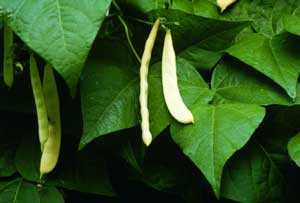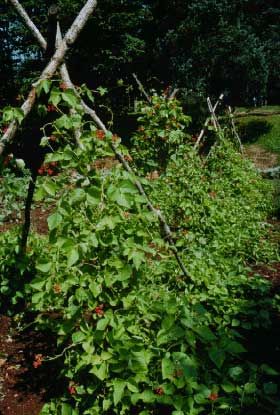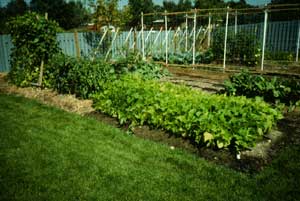Snap Beans
 |
We use the term “snap bean” to cover a bunch of different kinds of beans that you might choose to grow in the vegetable garden. The green ones are called “green beans” or “string beans”. The yellow ones are usually called “wax beans”. The flat ones are called “Italian green beans”, “broadbeans”, or “fava beans”. While there are lots of choices, virtually all of them require exactly the same growing techniques to produce lots of good food for the table.
These beans offer a bonus to the yardener as their roots accumulate and leave behind deposits of nitrogen in the soil to benefit future crops. Sort of like growing your own fertilizer. Various kinds of snap beans grow as bushes and others as vines. While usually grown in the garden, these beans grow well in containers. Snap beans are rich in complex carbohydrates and have some fiber and protein. They are a good source of vitamins A and C plus B vitamins, calcium and iron.
Snap beans are planted directly into the garden bed when warm weather arrives. They grow as bushes or vines, producing flowers that give way to long pods as they mature. The pods may be green or yellow or even purple. They may be anywhere from 5 to 7 inches long at maturity ("yard long" beans usually average 12 inches!). The pods may hang vertically from their stalks, either straight or somewhat curved. Various bean types produce round, oval or broad and flat pods. The pods of older bean varieties were distinguished by tough strings along pod seams, but modern types are virtually “stringless”.
Pole Beans vs. Bush Beans
 |
Pole beans grow on vines that must be trained to grow vertically on some sort of support. Typical plants may be 15 feet tall or more. Pole beans are great for growing in small spaces. They take a bit longer than bush types to form bean pods, but they’ll yield more beans overall if your growing season is over 120 days long (7 weeks), because each plant continues to bear until frost.
 |
Bush beans were originally developed for commercial farming, which demands bean plants that can be harvested mechanically and within a specific time frame. These plants average about 1 foot in height. In your garden, a bush bean crop will mature all at once within a few days, leaving you with a lot of leafy but unproductive plants the rest of the season. Usually you pull the bushes after the crop is harvested. To enjoy garden-fresh bush beans over the whole summer you’ll need to plant a batch of new seeds every couple of weeks, which is a technique called “succession planting”.

